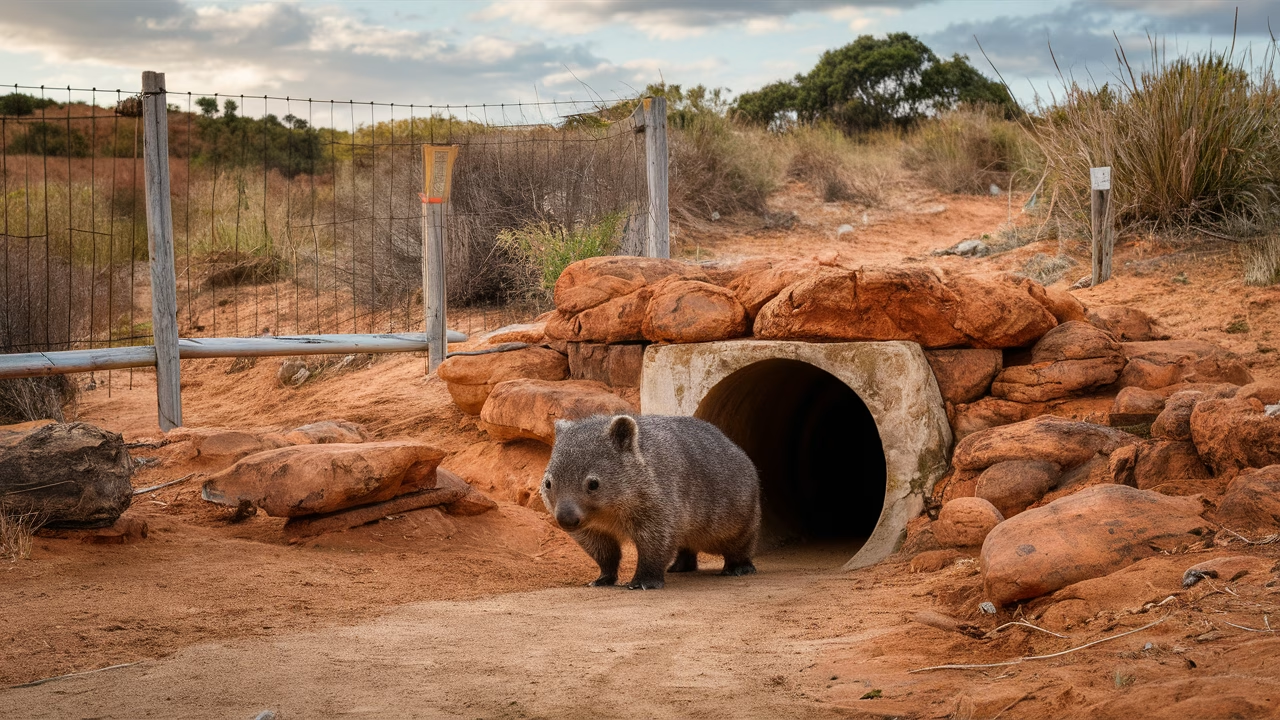How Fast Can Wombats Run When Threatened?
When threatened, wombats can run up to 25 miles per hour (40 km/h) in explosive bursts. This remarkable speed helps these stocky marsupials escape predators and dive into the safety of their burrows — a critical tactic in their threatened survival strategy that showcases their incredible physical adaptations.
TL;DR: The Speedy Secrets of Wombats
- Top Speed: Speedy wombats can sprint up to 25 mph (40 km/h) in short bursts.
- Reason for Speed: Used as a defense mechanism when chased by predators during threatened survival situations.
- Physical Adaptations: Stocky bodies, muscular legs, and low center of gravity aid their quick dashes.
- Unique Trait: Their thick-skinned rumps act as armor when diving into tunnels.
- Importance of Conservation: Without protected environments, wombats speed for survival becomes compromised, making conservation of wombats essential.
Introduction: Unveiling the Surprising Speed of Wombats
When you think of a wombat, chances are you imagine a furry, waddling marsupial — more likely to nap under a eucalyptus tree than race across the outback. But here’s where nature loves to surprise us: these speedy wombats can suddenly shift into high gear, bolting at speeds up to 25 mph. That’s faster than most humans sprint — particularly surprising given their short legs and barrel-shaped bodies.
So, why do wombats need that kind of speed? In one word: threatened survival. Unlike predators who rely on speed to hunt, wombats use it to escape, often dodging into their burrows where their reinforced backsides act as living barricades.
If you’re curious about what makes this possible or wondering how such speed fits into the broader picture of wombat behavior and conservation, buckle up. We’re about to tear down misconceptions and sprint into the fascinating world of wombats and their high-speed secrets.
The Anatomy Behind the Speed: Understanding Wombats Physical Adaptations
At first glance, wombats don’t look like they’d win any races. But their bodies are deceptively well-engineered for short, explosive motion. Understanding their wombats physical adaptations helps us appreciate their top-tier escape artistry and highlights the impressive design hidden behind their cuddly exterior.
Power in Compact Packages
Wombats are built low to the ground, which lowers their center of gravity. This makes them incredibly stable, especially on rugged terrain where quick reaction time is crucial. Their limbs are muscular with strong forearms and shoulders — adaptations originally evolved more for digging than sprinting, but incredibly useful in building burst momentum that makes these speedy wombats so effective.
Thick Rumps and Tunnel Tactics
Perhaps one of the most impressive wombats physical adaptations is their rear end. A wombat’s rump is made of extra-thick skin, cartilage, and bone. When chased, they can duck into a tunnel and use this reinforced rear as a blockade. Combined with their speed, this trait gives them a tactical advantage during threatened survival situations.
Lung Capacity and Sprint Design
Unlike marathon runners, wombats are built for sprints. Their lungs efficiently fuel high-energy output for 30–60 seconds. That’s just enough time to outrun a threat and vanish underground — their safe haven. In the wild, seconds can mean the difference between life and death for these remarkable marsupials.
Threatened Survival Mode: Exploring Why Wombats Kick into High Gear
Why would a peaceful, herbivorous marsupial need to run so fast? Because in Australia’s harsh outback, danger is never far away. From predators to habitat destruction, wombats often find themselves under threat. Let’s explore how their speed plays a crucial role in their threatened survival story.
Predator Evasion
Foxes, dingoes, and large birds of prey are natural enemies of wombats. When wombats sense danger, their instincts take over. Speed is their best chance at threatened survival — not to attack, but to escape using their remarkable wombats physical adaptations.
Escape and Evade
The goal isn’t to outrun the predator over long distances. Instead, speedy wombats aim to reach their burrow before capture. Their sprints are calculated — these animals know their terrain intimately. They navigate thorn-covered underbrush, slopes, and forest debris at high speeds, often surprising the animals chasing them.
Human-Caused Disturbances
Sadly, wombats today often face human-related threats more frequently than natural ones — habitat loss, encroaching developments, or vehicles. In these situations, their top speed can offer a crucial edge, helping them escape fatal accidents or navigate to safer spaces where conservation of wombats efforts can protect them.
Comparing Wombats to Other Animals: What Makes Them Unique
You might ask, “Is 25 mph really impressive?” Let’s put speedy wombats into context among other fast animals — especially other marsupials and burrowers to understand what makes their wombats physical adaptations so special.
| Animal | Top Speed | Size Comparison |
|---|---|---|
| Wombat | 25 mph (40 km/h) | Up to 40 inches long; 55–90 lbs |
| Kangaroo | 44 mph (70 km/h) | Much larger; built for hopping |
| Badger | 15 mph (24 km/h) | Similar digger lifestyle; slower |
| Rabbit | 30–35 mph (48–56 km/h) | Lighter; designed for fleeing predators |
Despite their chunky build, speedy wombats edge out many similarly structured animals. Their combination of burrowing adaptations, sprint capacity, and defensive capability make them particularly unique. They’re not just fast — they’re tactically fast, using their speed strategically for threatened survival.
From a wildlife biologist’s perspective, this makes them marvels of efficient design: evolution sculpted the wombat to survive in a niche both above and below ground through remarkable wombats physical adaptations.
Conservation Efforts: How Protecting Wombats is Essential for Their Speedy Survival
Without safe environments to flee into, even the fastest wombats speed becomes meaningless. Sadly, many wombat species, like the Northern Hairy-nosed Wombat, are critically endangered. Their populations are confined to isolated regions, reliant on carefully managed conservation of wombats programs to survive.
The Role of Burrows
Burrows aren’t just wombat homes — they are critical escape routes that make their threatened survival possible. When habitats are destroyed due to agriculture or urbanization, wombats lose these safe spaces. This compromises their primary defense strategy: run and hide using their remarkable speed and wombats physical adaptations.
Human-Wombat Conflicts
Many speedy wombats fall victim to vehicle strikes while trying to cross roadways at high speeds. Conservationists are working on solutions — from protective fencing to underroad wombat tunnels that allow safer crossings, supporting long-term conservation of wombats efforts.
Wildlife Conservation Efforts
- Programs that reintroduce wombats into secure habitats where their speed can be effectively used
- Monitoring of diseases like mange, which weaken their defenses and compromise threatened survival
- Community education that trains drivers and landowners to respect wombats and support conservation of wombats initiatives
Conservation of wombats isn’t just about preserving a cute species. It’s about protecting a biological marvel — an animal shaped by threatened survival, speed, and remarkable wombats physical adaptations. When wombats win, so does biodiversity.
Final Thoughts: More Than Just Speedy Marsupials
Sure, speedy wombats can zip across the bush at 25 mph — and yes, that’s astonishing. But what’s even more profound is what that speed reveals: resilience through remarkable wombats physical adaptations. It shows how evolution doesn’t always favor size or aggression but creativity and versatility in threatened survival situations.
Whether using their dense rear-ends as shields or sprinting to the sanctuary of a burrow, wombats are a lesson in adaptation. Let’s not forget: without proper conservation of wombats efforts, even the fastest wombat can’t outrun habitat loss. By understanding, celebrating, and protecting these lovable powerhouses, we ensure that their future is as dynamic as their dashes through the wild.
Frequently Asked Questions
- How fast can a wombat run?
- Speedy wombats can reach speeds of up to 25 mph (40 km/h) when threatened — a surprising feat for such chunky marsupials with remarkable physical adaptations.
- Why do wombats need to run fast?
- Wombats sprint during threatened survival situations to escape predators or dangers, using their speed to reach the safety of their tunneled homes.
- How long can wombats maintain their top speed?
- Speedy wombats can maintain near-top speeds for 30–60 seconds — long enough to reach a burrow and evade danger in threatened survival scenarios.
- Is wombat speed useful against predators?
- Absolutely. Their fast dash, followed by blocking the burrow with their hard rump, showcases perfect wombats physical adaptations that make them very difficult to catch.
- Are wombats endangered?
- Some species, like the Northern Hairy-nosed Wombat, are critically endangered due to habitat loss and disease, making conservation of wombats efforts crucial.
- Can wombats be dangerous to humans?
- Wombats are not aggressive but can defend themselves if cornered using their speed and physical strength. Though solitary, they usually avoid human contact.
- What conservation efforts help wombats?
- Conservation of wombats efforts include habitat protection, disease control, and public education on avoiding road collisions and habitat destruction.




